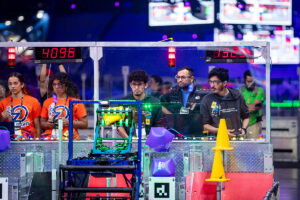
Hundreds of high school students from Utah and surrounding states converged on the Maverik Center for the Utah Regional FIRST Robotics Competition last weekend. The annual tournament, co-organized by the University of Utah’s John and Marcia Price College of Engineering, involves teams designing and building robots that play a physical, action-packed game against one another.
The FIRST (For Inspiration and Recognition of Science and Technology) Robotics Competition aims to promote science and technology education for high school students around the world, fostering a new generation of engineers, programmers, and scientists.
“FIRST gets kids involved in STEM in a fun way, solving real-world science, engineering, and business problems. Those aspects are critical for developing our economy and future leaders,” says Mark Minor, associate professor in the Price College’s Department of Mechanical Engineering and Organizing Chair of the Utah Regional FIRST Robotics Competition.
“It also prepares them to come to the U with skills that go beyond engineering. Just learning how to be part of a team is so important for emotional support, building confidence, and making friends.”
Minor and his colleagues at the University of Utah Robotics Center first organized the state’s chapter of the national robotics competition as an outreach program through a National Science Foundation grant in 2010 and have been helping run the annual event since.
To participate, students form teams, then are tasked with designing and building an industrial-size, semi-autonomous robot to compete in this year’s FIRST game.
Called “Crescendo,” this year’s game requires robots that can pick up foam rings — called “notes” — then fling, flip, shoot, and drop into various scoring chambers situated around a field of play about the size of half a tennis court. Coordination between robots, along with well-timed actions from their humans, can earn teams bonus points.
Teams must program their robots to operate autonomously for the first 15 seconds of the two-and-a-half-minute matches, then may manually pilot them to execute more complicated maneuvers. Teams must therefore engineer their robots with high degrees of mechanical precision and reliability, but also develop strategy, teamwork, and other interpersonal skills, in order to come out on top.
The latter are particularly important in FIRST, as each match is between two alliances of three teams and their robots; while individual teams have had months to fine-tune their designs and strategies amongst themselves, they must also be ready to quickly coordinate with the other members of their alliance in each match.
In the spirit of FIRST’s principle of combining competition with cooperation, opposing alliances can also score “Coopertition Points” by coordinating with each other at certain times in the match. Beyond boosting the alliance’s score, Coopertition Points also improve teams’ overall standing in the tournament rankings.
“’Coopertition’ fosters innovation by promoting unqualified kindness and respect in the face of intense competition,” says Kris Nelson, Regional Director of the Utah FIRST Robotics Competition. “At FIRST, in every interaction, Coopertition means that teams help and cooperate with each other, even as they compete. It’s about learning from teammates, teaching others, collaborating with mentors, managing, and being managed. Coopertition embodies the spirit of competing while assisting and enabling others whenever possible.”
The winners of the Utah Regional Competition, as well as recipients of select technical and performance-based awards, now have their sights set on the FIRST Championship, held April 17–20 in Houston.